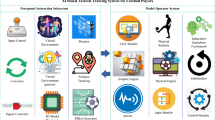Abstract
The traditional way of football training could be subject to some factors such as the field, and the problems and scenes in the training can not be recovered fully. Thus, this paper proposes a football training method based on the improved tiny-yolovs3 model and the virtual reality (VR). Firstly, the paper makes use of the improved tiny-yolov3 model to detect the football in motion. Then, the paper uses the binocular camera to get the coordinates of the football. Finally, the paper reproduces the position of football in the virtual reality environment. The experimental results show that the football training method is feasible.













Similar content being viewed by others
References
Banks J, Corke P (2001) Quantitative evaluation of matching methods and validity measures for stereo vision. Int J Robot Res 20(7):512–532
Everingham M, Winn J (2006) The PASCAL visual object classes challenge 2007(VOC2007) development kit. Int J Comput Vis 111(1):98–136
Fang D, Nayga RM, West GH, Bazzani C, Snell HA (2020) On the use of virtual reality in mitigating hypothetical bias in choice experiments. Am J Agricult Econ 103(1):142–161
Fransson PA, Patel M, Jensen H, Lundberg M, Tjernstrom F, Magnusson M, Hansson EE (2019) Postural instability in an immersive virtual reality adapts with repetition and includes directional and gender specific effects. Sci Reports 9
Gazda J, Florek M (2012) Economic and non-economic effects of hosting mega sport events. Poland and the uefa euro 2012 case study. Actual Probl Econ 133:32–39
Girshick R, Donahue J, Darrell T, Malik J (2014) Rich feature hierarchies for accurate object detection and semantic segmentation. Proc IEEE Conf CVPR:580–587
Hartigan JA, Wong MA (1979) Algorithm AS 136: a K-means clustering algorithm. J Roy Stat Soc C, Appl Statist 28(1):100–108
He K, Zhang X, Ren S, Sun J (2016) Deep residual learning for image recognition. Proc IEEE Conf CVPR:770–778
Huang G, Liu Z, Laurens VDM, Weinberger KQ (2017) Densely connected convolutional networks, in proc. IEEE Conf, CVPR
Kohavi B, Beato M, Laver L, Freitas TT, Chung LH, Dello Iacono (2020) Effectiveness of field-based resistance training protocols on hip muscle strength among young elite football players. Clin J Sport Med 30(5):470–477
Liu W, Anguelov D, Erhan D, Szegedy C, Reed S, Fu C-Y, Berg AC (2016) SSD: single shot multibox detector. Proc. Eur. Conf. Comput. Vis. Cham, Switzerland: Springer, pp. 21–37.
Mcgrane A, Bird N, Arten C, O'Sullivan K (2020) “All my problems go way for 90 minutes”: how football and psychotherapy improves young Men’s mental health. Am J Mens Health 14(5)
Propheter G (2019) Professional sports as economic activity magnets: some evidence from employment microdata. J Urban Aff 61(6):842–852
Redmon J, Farhadi A, YOLOv3: An incremental improvement, 2018, arXiv: 1804. 02767. [Online]. Available: https://arxiv.org/abs/1804.02767
Redmon J, Divvala S, Girshick R, Farhadi A (2016) You only look once: unified, real-time object detection. Proc IEEE Conf Comput Vis Pattern Recognit:779–788
Ren S, He K, Girshick R, Sun J (2015) Faster r-cnn: towards real-time object detection with region proposal networks. IEEE Trans Patt Anal Mach Intell 39(6):1137–1149
Tarzi C, Aubrey J, Rotundo M, Armstrong N (2020) MD. Cusimano, professional assessment of potential concussions in elite football tournaments. Injury Preven 26(6):536–539
Wu XJ, Chen HM, Wu XL, Wu SJ, Huang JB (2020) Simultaneous localization and mapping of medical burn areas based on binocular vision and capsule networks. Soft Comput 24(23):18155–18171
Yin HP, Chen B, Chai Y, Liul ZD (2016) Vision-based object detection and tracking: a review. Acta Automat Sin 42(10):1466–1489
Yu Y, Mo Y (2017) Deep learning principles and tensorflow practice. Publishing House Electron. Ind, Beijing, pp 88–98
Zhang ZY (1999) Flexible camera calibration by viewing a plane from unknown orientations, Seventh IEEE Int Conf Comput Vision
Author information
Authors and Affiliations
Corresponding author
Additional information
Publisher’s note
Springer Nature remains neutral with regard to jurisdictional claims in published maps and institutional affiliations.
Rights and permissions
About this article
Cite this article
Xiao, D., Niu, J. & Feng, J. A football training method based on improved tiny-yolov3 and virtual reality. Multimed Tools Appl 81, 14283–14301 (2022). https://doi.org/10.1007/s11042-022-12404-2
Received:
Revised:
Accepted:
Published:
Issue Date:
DOI: https://doi.org/10.1007/s11042-022-12404-2




